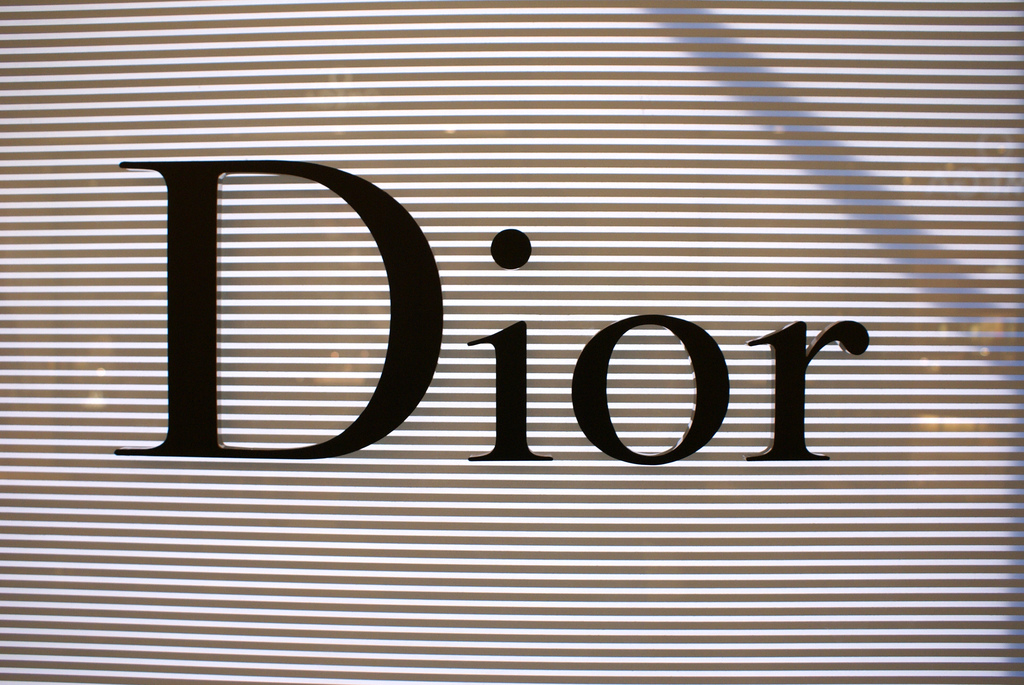
Christian Dior, born January 21, 1905, restored the hourglass to women’s fashion in the bleak aftermath of World War II. The corseted waists and full skirts of the New Look found wild success — and some criticism — in the middle of last century, establishing Dior as a major player in the industry and defining the look of the 1950s. Below, Dorothy Rompalske recounts the impact of Dior’s revolutionary 1947 fashion show, how the look got its name, and why so many were against it.
In one fell swoop of a pleated skirt, the drab and practical fashions of the war years were replaced with the fanciful silhouettes of upside-down flowers. Gone were boxy wool suit jackets, short fabric-saving skirts, and chunky wedge-heeled walking shoes. In their place appeared low-cut bustier tops, tightly cinched waists, long flowing skirts, and high heels. The hourglass shape – what Dior called the “figure 8” – was back, achieved with the help of meticulous tailoring that incorporated stiff bone corsets, taffeta linings, and plenty of padding around the hips.
At the end of the fashion show, stunned audience members leapt to their feet in applause, then crowded around the timid 42-year-old couturier to offer congratulations. “It’s quite a revolution, dear Christian,” gushed the influential editor of Harper’s Bazaar, Carmel Snow. “Your dresses have such a new look.” Snow’s famous pronouncement stuck and, in a world anxious to forget the hardships of wartime, the style revolution that came to be known as the New Look was a smash success.
In no time at all, a bevy of famous beauties were spotted in their new Diors – glamorous Hollywood stars including Rita Hayworth, Marlene Dietrich, and Olivia de Havilland, and such well-known trend setters as the Duchess of Windsor and Argentina’s Eva Peron. Within three short months, Christian Dior originals had crossed the Atlantic to the best American shops. Soon afterward, low-cost interpretations of his most popular dresses were on racks at almost every department store.
But not everyone was favorably impressed. Times were lean, and many people were angered by the designer’s excessive use of scarce materials (one popular New Look skirt required 17 yards of fabric to construct, instead of the standard three). In England, where cloth rationing was still in place, voices were raised in moral outrage against Dior over such indulgences. And in a famous incident captured on newsreels for the world to see, a group of dowdy Paris housewives became so enraged at the sight of several women sporting new Dior dresses that they tore the clothes right off their backs. Women who refused to be seen in outdated frocks but who weren’t rich were often forced to take matters into their own hands: “Anything you had from before was totally out of style,” remembered Francoise Giroud, then-editor of French Elle. “All around Paris, women were ripping down their curtains to run up new outfits.”
In the United States, some 300,000 Dior detractors joined the Little Below the Knee Club, a nationwide effort to preserve America from the ankle-sweeping New Look, while a group of tapped-out men in Georgia formed the League of Broke Husbands, determined to “hold that hemline.” Women protested against the way the uncomfortable new fashions constricted their ability to move – evening dresses could weigh as much as 60 pounds and were so tight and stiff their wearers complained they were unable either to dance in them or comfortably sit. And a California woman’s misadventures in a Dior-inspired skirt gave the term “fashion victim” a literal meaning. “As she alighted from a bus,” Time magazine warned readers, “her new long, full skirt caught in the door. The bus started up and she was forced to run a block before the bus stopped and she was freed.”
Normally an anxious man, Dior managed to appear nonplussed as he responded to criticism in the press: “The magazine identified the couturier as “a timid, middle-aged insignificant-looking Frenchman…who would be instantly picked by anyone familiar with whodunits as the character least likely to be suspected. M. Dior.” The magazine continued, “looks extraordinarily like a Kewpie doll, is short, round, bald; wears dark, dowdy, unpressed suits, office-worker ties and shirts and pointed shoes.”
Christian Dior’s humble appearance belied a privileged upbringing in Paris and Granville, a small resort town on the coast of Normandy. Born January 21, 1905, he was the second of five children of a wealthy, upper-middle-class fertilizer manufacturer named Alexandre Dior and his highly image-conscious wife, Madeleine. By most accounts it was a happy childhood, even though Christian, who was a quiet and delicate child, appeared vastly different from his hardier siblings. Rather than join in their rough-and-tumble games, he preferred to follow his aloof mother, whom he adored, around the family property. In a bid for her attention, he spent long hours helping Madeleine as she indulged in her passion for gardening and beautifying their homes.
Though Dior’s New Look fashions would later be touted as revolutionary, they actually call to mind the tightly corseted Belle Epoque dresses that his mother wore on those happy days spent in her gardens. As Dior biographer Marie-France Pochna notes, “In his heart of hearts, in the depths of his soul, Madame Dior was present in every fold, in every yard of fabric unfurled by the designer in his yearning for ‘le temps perdu.’ She was both his critic and his inspiration.”
—Excerpted by Jodie C. Liu.
*Photo courtesy superciliousness.




Send A Letter To the Editors